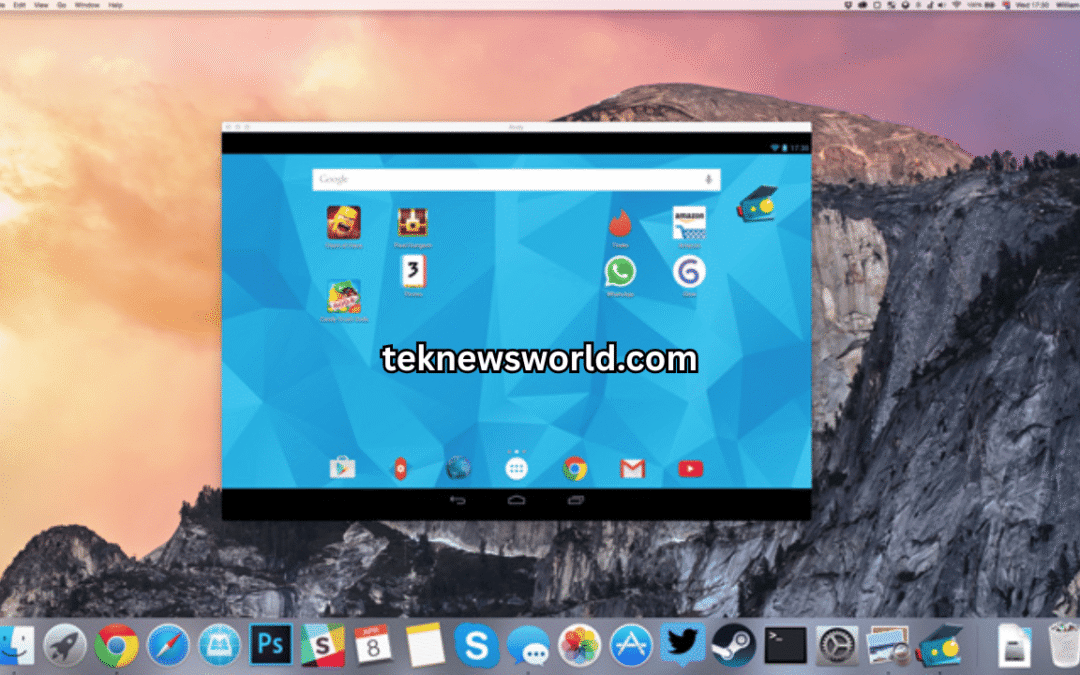The environment of the Android emulator Mac has evolved into a crucial element in Android development processes, allowing developers to replicate devices extensively without depending on physical devices. macOS offers a strong foundation for efficient emulation, featuring GPU acceleration, HAXM-driven hardware virtualisation and comprehensive performance profiling options.
These attributes are essential for performing advanced Android automation processes, verifying user engagements and guaranteeing that applications uphold stable performance across numerous device configurations and API versions. Effective use of GPU pipelines, CPU virtualisation and profiling tools ensures consistent emulator behavior that aligns closely with actual device performance, aiding both development and ongoing integration processes.
GPU Rendering on macOS
GPU rendering is integral to realistic UI emulation and to responsive animations in the Android emulator. The Mac emulator uses multiple graphics backends, including OpenGL and Metal, providing API support, which allows more rendering tasks to be offloaded from the CPU to the GPU. Such offloading leads to reduced frame latency, input lag and dropped frames while performing complex UI operations.
The Android Virtual Device (AVD) Manager provides three main GPU configurations:
- Automatic: Alternates between hardware and software rendering according to the host GPU’s capabilities.
- SwiftShader: A renderer that operates via software when hardware acceleration is either unavailable or not compatible.
- Hardware GLES 2.0/3.0: Dedicated hardware acceleration designed for Macs with dedicated GPUs, perfect for graphics-heavy applications.
Profiling tools such as Android Studio GPU Profiler can give rich metrics about GPU use, memory allocation and frame latency, and with an automation script, the time these scripts require should not interfere with the accuracy of tests or timing-sensitive interactions related to GPU-heavy operations. Developers can leverage profiling tools to find the cause of bottleneck rendering during their applications, optimize GPU programs once, and understand how to best manage texture memory to improve their application’s performance.
HAXM: Hardware Acceleration on Intel Macs
Intel HAXM (Hardware Accelerated Execution Manager) enables near-native performance for Android emulators on Intel-based Macs. It leverages VT-x virtualization to efficiently execute x86 system images. Installation requires verifying CPU virtualization support, allocating appropriate memory and configuring CPU cores per emulator instance.
Memory configuration is crucial; over-allocation can trigger macOS swapping, causing lag, while under-allocation may restrict emulator functionality. HAXM integrates closely with macOS, allowing seamless context switching between guest and host processes.
Running multiple emulator instances concurrently is seamless with HAXM, supporting regression testing across multiple API levels and screen densities. Automated testing frameworks like Espresso, UIAutomator and Appium take advantage of the low-latency environment, guaranteeing precise input execution and consistent results throughout extensive automation processes.
Emulator Performance Profiling
Comprehensive performance profiling covers CPU, memory, GPU, network and I/O metrics. Real-time monitoring and historical analysis are possible using Android Studio Profiler, Traceview and third-party tools.
- CPU Profiling: Thread-level metrics highlight hotspots associated with rendering pipelines, background services and scripts, enhancing the application’s responsiveness.
- Memory Profiling: Memory leak, memory allocation, and frequency of garbage collection are tracked to avoid application crashing during long-running tests.
- Network Simulation: Bandwidth throttling, latency, and packet loss simulation created realistic network scenarios when testing applications. Automation scripts could validate proper app behavior under various connectivity.
- Frame Rendering Metrics: GPU load, dropped frames and latency are captured to maintain smooth UI interactions and reliable automation execution.
Optimizing Emulator Performance
Enhancing Android emulator performance on Mac involves several strategies:
- System Image Selection: Use x86/x86_64 images for Intel Macs to benefit from HAXM acceleration; ARM images are slower unless executed on Apple Silicon.
- Resource Allocation: Configure memory, CPU and GPU based on the application complexity and test requirements.
- Snapshot Mode: Preserves emulator state to reduce startup times and support rapid test iterations.
- Profiling-Based Iteration: Constant monitoring of CPU, GPU and memory use allows for gradual optimization without trial and error.
Android Automation and Emulator Performance
Emulator performance is pivotal in automated testing workflows. Even minor delays in GPU rendering or CPU processing can introduce test flakiness, leading to unreliable results. Profiling these metrics is essential to mitigate such issues, ensuring consistent and reproducible outcomes.
Cloud-based platforms like LambdaTest extend the functionalities of emulators beyond the constraints of local hardware. They enable teams to execute extensive automated test suites concurrently by provisioning multiple emulator instances on macOS and Windows hosts. This scalability is crucial for comprehensive testing across various environments.
LambdaTest’s performance analytics tools provide insights into CPU, GPU, and memory metrics, assisting in the optimization of emulator settings. These analytics are particularly beneficial when integrated with CI/CD pipelines, enhancing regression testing efficiency and ensuring uniform results across diverse device models and OS versions. This integration minimizes bottlenecks in extensive Android automation processes.
Advanced Profiling Techniques
Advanced profiling provides granular insights into emulator behavior:
- Traceview and Systrace: Visualize system calls, thread scheduling and event propagation.
- Allocation Tracker: Monitors object allocation and garbage collection patterns over time.
- CPU Profiler: Provides method-level execution timing for precise performance tuning.
- GPU Debugger: Examines GPU program execution, texture memory usage and Metal/OpenGL pipelines for rendering bottlenecks.
Used alongside automated scripts, these tools enable reproducible benchmarking, helping developers track regressions and optimise performance consistently.
HAXM vs Apple Silicon Performance
Intel Macs rely on HAXM, whereas Apple Silicon devices like M1 and M2 require ARM64 images and macOS virtualization frameworks. While ARM emulation reduces translation overhead, legacy x86-dependent libraries may still require hybrid CI setups or cloud-based solutions.
The integrated GPU architecture of Apple Silicon differs from Intel and discrete GPU setups, impacting rendering pipelines and shader behavior. Profiling must account for these differences to ensure consistent emulator behavior and reliable automation results across architectures.
Advanced Emulator Optimization
High-demand workflows benefit from advanced strategies:
- Dynamic allocation of resources: In real time for CPU and memory usage according to profiling data.
- Parallel execution: A multi-threaded scheduler for multiple AVD instances.
- Network conditioning: Simulate a variety of networking conditions to perform robust automation testing.
- Incremental rendering optimization: Performance can be analyzed in a bottleneck profile frame by frame for more complex UIs.
These methodologies provide a level of assurance that an emulator will perform consistently when operating at a high load and produce stable Android automation pipelines.
Emulator Disc I/O Optimization
Disc I/O performance significantly impacts emulator responsiveness. Virtualized storage manages system images, application data and temporary caches, and slow access can delay app launches and automation tests. macOS developers can improve performance using fastboot snapshots, preallocating disc space and leveraging SSD storage over HDDs. Disc caching and optimized AVD storage settings ensure stable performance across test scenarios. Efficient I/O minimizes CPU and GPU bottlenecks, maintaining smooth emulator behavior during automated regression runs and large-scale automation pipelines.
Multi-AVD Synchronization and Resource Management
Running multiple AVD instances enhances test coverage but risks resource contention. Efficient multi-AVD execution requires CPU core assignment, memory partitioning and GPU scheduling. Dedicated CPU threads and careful monitoring prevent swapping and slowdowns. GPU scheduling ensures that graphics-intensive tasks from one emulator do not affect others. This strategy, combined with cloud-based scalability, allows parallel execution of regression tests across API levels and device configurations. Profiling ensures balanced CPU, GPU, memory and disc usage, maintaining consistent timing and performance in automated workflows.
Enhancing Emulator Responsiveness with Thread Management
Thread management plays a crucial role in achieving stable performance across multiple AVD instances. Each emulator relies on threads to handle rendering, input events, background services and automation script execution. On macOS, thread contention can occur when multiple AVDs or background processes compete for CPU resources. Proper thread prioritization and assignment reduce latency in input processing, frame rendering and network operations. In combination with Android Studio Profiler, tools such as Activity Monitor enable developers to pinpoint thread bottlenecks and modify emulator settings in real time. Optimizing thread distribution enhances both manual testing and automated processes, guaranteeing high-quality Android automation even in demanding situations.
Network Simulation for Real-World Testing
Simulating network conditions is increasingly important for testing real-world application behavior. The Android emulator provides developers with the ability to limit bandwidth, create packet loss, and add latency to build mobile network conditions. Network conditioning is necessary to ensure that an automated test properly asserts functional correctness, resilience and responsiveness in changing connectivity. For example, GPU-heavy animations or data-heavy operations will render (differently) on a 4G or 5G connection, in contrast to Wi-Fi.
Profiling connectivity metrics alongside CPU, GPU, and memory metric scores provides overall performance, which will allow developers to improve performance on the emulator and the application. Including this type of testing in CI/CD pipelines will allow these insights to scale up efficiently and continue our history of enabling regression and performance testing on many combinations of device and network.
CI/CD Integration
Profiling and optimization can be fully integrated into CI/CD pipelines. Automated processes launch emulator instances, execute Android automation scripts, and capture metrics for reporting. Combining local Mac emulators with cloud scaling ensures high coverage across devices, OS versions and screen densities. This approach reduces execution time, improves parallelism and provides detailed performance insights, supporting continuous deployment and reliable regression testing.
Conclusion
Optimizing the Android emulator Mac environment requires a complete approach encompassing GPU rendering, HAXM acceleration, disc I/O, multi-AVD resource management, thread allocation, network conditioning and detailed profiling. Efficient memory and CPU allocation, combined with rendering insights, ensures predictable behavior under manual and automated testing.
Techniques like dynamic resource allocation, parallel execution and network conditioning enhance emulator fidelity, especially in large-scale Android automation workflows. CI/CD integration allows continuous performance validation, reducing regressions and accelerating release cycles. Implementing these strategies enables near-native performance on macOS emulators, creating a robust and reliable environment for Android development, testing and deployment.


